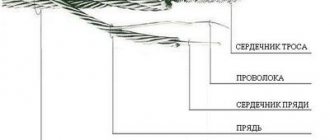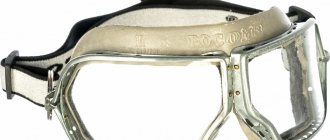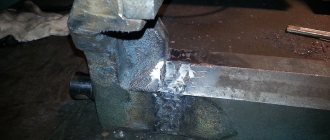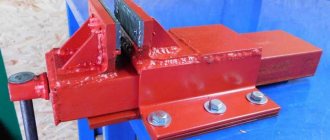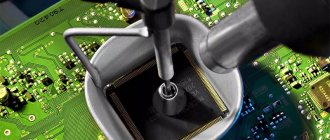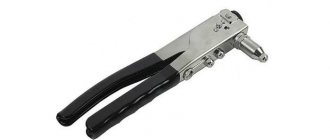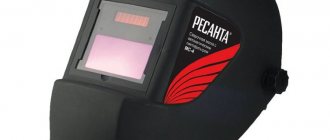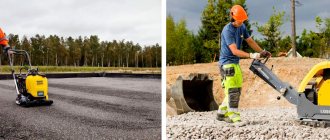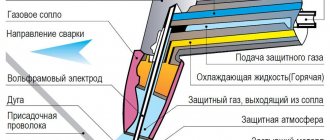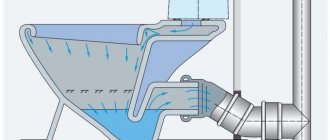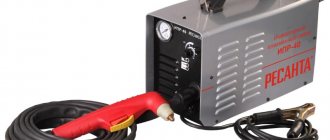Types of vices
Locksmiths
. This is an all-metal vice, they are placed on a workbench or fixed to a tabletop with bolts. There are two types of bench vices - stationary and rotary (rotary). These jaws range in width from 4.5 to 20 cm, and the running lip can be extended by about 14 cm.
For example, the Stayer Master cast iron bench vice has a rotating mechanism, it weighs about 6 kg, the width of the jaw is 9.5 cm. They are coated with wear-resistant blue paint and cost up to 1200 UAH.
Among the advantages are excellent assembly and fit of parts, a complete anvil and the working part of the jaws with a fixing relief surface (you work without fidgeting of the part - everything is firmly fixed). In addition, the attachment system to the machine or table does not cause any complaints. This vice is small, but the area of the working part allows you to process larger parts.
The only downside is that it requires additional tools to install the vice.
Another example is the more compact bench vice INTERTOOL HT-0054: they also have a rotating mechanism, weigh less - 2.9 kg and the width of the jaws is also 6 cm. The previous model is cast iron, this one is steel, and costs less - 250 UAH.
Intertool has the ability to change jaws, and installation and dismantling can be done quickly and without additional tools. The vice is relatively compact and well assembled; one of the disadvantages is the small width of the jaws, but for some types of work it will be enough.
Machine tools.
Such a vice does not play. You can do more precise work with them. A machine vice is a typical production tool found on industrial workbenches for processing particularly large parts, and the rotating mechanism allows for more precise adjustment of the parts requiring processing.
A typical example of a machine vice is GROZ TLT/SP/50: with a rotating mechanism, weighing just over 4 kg. The width of the jaws is 5 cm. This model is cast from cast iron, the movable lip extends 25 cm. Possibilities include three-axis adjustment of the workpiece during milling, drilling, sharpening, shaping and contour drilling. There are two inclined planes: at 45° and vertically at 90°.
GROZ benefits from its competitors due to its relatively compact size with a sufficient working surface area; in addition, 4 kg is light weight for this class of equipment; cast iron is resistant to mechanical damage. But to install such a vice, you need auxiliary tools and special preparation of the working surface before installation. Steel vices are also available in this category - with a weight of 3.2 kg.
Carpentry
. They are used when working with wooden or plastic workpieces, fastening them to the table with bolts. The jaws of the carpenter's vice, due to the characteristics of the materials being processed, have special protective pads (also made of wood). For some models, the clamp may be combined - cast iron and wood.
The weight of some carpentry vices can reach or even exceed 16 kg, but the width of the jaws is significant - 22 cm or more. Carpenter's vices are often made of cast iron for greater stability. The average extension of the movable lip in this class is 12 cm.
Manual.
The simplest (and inexpensive) type of vice. These are, as a rule, oversized devices with a simple design, thanks to which you can comfortably work with small parts without even placing a vice on the table.
A good example is JONNESWAY P30M07A. Compare: the weight of a machine vice exceeds 5-6 kg, while manual ones weigh about 0.6 kg. To facilitate the design, these are often made of steel with an admixture of chromium and vanadium - for greater strength and wear resistance. The dimensions of this model are 30x9x2 cm, just what you need for small work! Due to the additives in the alloy, Jonnesway is a vice that is resistant to temperature changes, including high temperatures and damage. They are ergonomic: they fit comfortably in the hand, weigh little and have reliable protection against metal corrosion and cost from 220 UAH.
This set of advantages determines the price, which is high by the standards of other hand vises.
Each type of vise has steel and cast iron models. So which vice is better - cast iron or steel? Cast iron will give more stability due to weight and may cost a little less, but steel has greater strength (especially not cast steel, but forged, i.e. made using hot stamping technology).
It’s convenient to choose a vice and compare prices on Price.ua.
Best Steel Vices in 2021
Wilton Q75 75×80 mm
First of all, we suggest you consider an interesting model that is great for drilling. This option can be used both in industrial production and in your garage at home. The product is installed on the frame using four grooves. Each is 6 centimeters long. Special spiers are inserted into them.
The frame has special slots that make it easier to accurately place an object. The width of the vice is 7.5 centimeters. This is quite enough to fix a square, plate or short pipe.
Pros:
- Low weight compared to other models. Only 2 kilograms;
- The cost is around 1000 rubles;
- The width of the vice is almost 8 centimeters;
- Compact handle for clamping, which does not interfere when working with an object;
- There are notches on the surface of the clamping jaws for tighter pressing;
- You can cool the tool with water since it is made of stainless steel.
Minuses:
- There is a slight play in the moving lip that is difficult to eliminate;
- There is no limiter;
- There are a lot of burrs on the casting.
Russia 140 18667
As the name implies, the next version is produced in Russia and is aimed at the domestic market. Experts note that this model is ideal for car services. The main feature is a reliable and durable design, which allows the tool to serve effectively for many years. The material used in production is steel marked C35L.
The clamp width is 14 centimeters, which is almost 2 times more than in the previous version. This tool allows you to tightly clamp the channel, hub and other massive parts. There are rubber pads on the side ends of the rod that increase user safety.
Pros:
- The surface of the jaws has a corrugated structure, which increases the clamping density;
- Small dimensions that allow you to place the device on a table;
- Nice color;
- A reliable bushing is provided on the main working shaft;
- U-shape, which fits most parts perfectly;
- Three-point fastening.
Minuses:
- Anvil is missing;
- High cost from 6 thousand rubles;
- Large weight of 15 kg, which does not allow placing the product on a regular table. You need a specialized workbench. And also difficult to transport.
RIDGID 25 40100
The next model is designed for clamping pipes. They can accommodate a pipe with a diameter from 6 millimeters to 10 centimeters. You can quickly place and remove an object by folding down the hook-shaped top part of the product. The screw is only needed for tight clamping when the pipe is already in the tool.
Pros:
- Robust design with reinforcements on the sides;
- Stroke from 0.6 to 10 cm;
- Quickly remove the pipe from the tool using the folding top;
- The plates are made of alloy steel;
- Reliable and dense coverage;
- There are limiters at the ends.
Minuses:
- The body cannot be rotated;
- Extremely high cost from 25 thousand rubles.
Wilton WWV/175 65017EU
Another Wilton brand model that will be discussed in this list is called WWV/175 65017EU. As a rule, such a tool is used in carpentry workshops. It is excellent for cutting thick timber, since the opening width is 21 centimeters. The height of the sponges is 7 centimeters. Thanks to this, the load is distributed evenly enough so as not to harm the wood.
The design has special holes necessary for installing the product on a table. In addition to the screw, there are 2 additional stainless steel guides. They strengthen the device.
Pros:
- The screw is made of thick cast iron;
- The product is made of materials that cannot corrode;
- The shaft has a fine thread, which makes the move smoother;
- The small dimensions of the product allow it to be placed on a small table;
- There are no notches on the jaws. This is done so as not to damage the object being pressed;
- Good indicator of spreading width.
Minuses:
- The product cannot be rotated;
- There is no clear parallelism;
- Cost from 4 thousand rubles.
SPARTA 186255
If you need a budget, simple vice for working in your garage, then you should pay attention to the SPARTA 186255 model. The opening width is 12.5 centimeters. This allows you to handle most wide parts, as well as perform many types of work on them. At the same time, a convenient anvil is provided here.
The main feature of this design is its excellent strength. There is reinforcing casting along the entire perimeter of the structure. Thus, this model will serve the master for many years with maximum efficiency.
Pros:
- Compact dimensions allowing the product to be placed on the table;
- High clamping power;
- The presence of four holes for tight fastening;
- Budget cost is around 1800 rubles;
- Presence of an anvil;
- The jaws have a corrugated surface, which will not allow the object to slip out;
- Impressive depth of the jaws, which allows you to capture massive objects;
- Most parts in the assembly are stainless;
- Attractive design with nice colors.
Minuses:
- It is not recommended to tighten the object too tightly as it may crack;
- Large mass. Must be installed on a sturdy table or workbench.
Triton SJA100E TR281928
The next model can be called a new product. It appeared in 2017 and has already taken a strong position in the domestic market. The main feature of this vice is its opening width. They can open even to the width of the door. If you need to clamp a massive object and other options are not suitable, then this is the best choice.
There is a missing screw here. The mechanism operates on the principle of a foot drive. At the same time, the sponges themselves can be moved apart by hand if the mechanism is loosened. This is convenient because you don’t need to unscrew the screw for a long time.
Pros:
- Massive sponges;
- Durable housing;
- Maximum load – 200 kilograms;
- The presence of legs for installation on a horizontal surface. Due to this, a table is not needed;
- The spreading width is almost a meter;
- The legs themselves can be folded compactly;
- You can rotate the product in any direction.
Minuses:
- The device weighs 14.5 kilograms, which complicates transportation;
- High cost from 9.5 thousand rubles.
BISON Expert 32731-175
Next up is the ZUBR Expert brand carpentry vice. Manufacturers were able to achieve excellent quality at a pleasant and affordable price. This model is designed for fixing wood. It is noteworthy that the screw has a trapezoidal thread. This improves the fastening efficiency as well as the durability of the material. For smoother and more correct pressing, two stainless steel guides are made.
The product can be tightly fixed on the workbench using hardware. It is worth noting that the manufacturer provided 2 small holes on the jaws. They are needed if the user wants to install overlays on them.
Pros:
- The jaws and screw have no play. The ride is smooth and uniform;
- The width of the sponges is almost 20 centimeters;
- Versatility;
- The screw belongs to the quick-clamping category.
Minuses:
- There is too much grease on the parts that gets onto the object.
Kobalt 246-012
Kobalt 246-012 is a high-quality rotary vice that works in two planes: horizontal and vertical. In addition to good quality and efficiency, the manufacturer paid attention to appearance, creating an attractive design. The jaws and screw are made of durable stainless steel. In this case, the sponges can be replaced if necessary.
The product is equipped with an anvil for impact work. It does not have such a large area, but most modern vices do not have such a module at all. Fastening to the workbench is carried out using 4 bolts or self-tapping screws. Their length should be 8 mm. The main disadvantage of this model is the inconvenient and fragile handle, which is difficult to work with.
Pros:
- Durable jaws and screw made of stainless steel;
- Impressive stroke width;
- Attractive design and nice coloring;
- You can work in two planes.
Minuses:
- Inconvenient and fragile handle.
Zubr 32611-2 2438
The next model is designed to work with pipes. It is manufactured by Zubr. The first model allows you to tightly fix pipes, the diameter of which varies from 5 to 9 centimeters. The body is made of steel, which is protected from corrosion by a special coating. The mass of such a product is about 5.62 kg. Thus, it can be easily transported. However, to work effectively, you need to fix the device on a table or workbench.
The sponges are also made of durable material, and their surface has a relief shape. This allows you to fix the pipes with maximum reliability.
pros:
- Effective fixation of pipes;
- Low cost;
- Reliable assembly from quality materials;
- Comfortable and reliable handle.
Minuses:
- Narrow focus;
- Lack of features.
Zubr 32712-100
Next up is another product from the Zubr company, but this time not for fixing pipes. This model is universal and suitable for many workpieces. The manufacturer uses cast iron marked SCh-25 as the main material for the manufacture of such tools. The surface of the jaws has a corrugated surface.
The basic kit includes additional elements for replacement. The base can be rotated along a horizontal plane. Thus, the master can fix the workpiece in the most convenient position. To accurately measure the distance between the jaws, a special scale printed on the body is used. A small anvil is provided.
Pros:
- Compact dimensions;
- Availability of a measuring scale for accurate calculations;
- The manufacturer has ensured smooth and uniform movement without backlash;
- Budget cost.
Minuses:
- Inconvenient small handle;
- The casting was done poorly.
WEDO TSCH-180
The following vices are bench vices. Their production has been established with the cooperation of specialists from Russia and Belarus. The base is made of cast iron and the jaws are made of steel. Experts note the excellent build quality. At the same time, the cost is quite reasonable. It is worth noting the increased stability of the device. It can be used even without fixing it to a table or workbench. At the same time, comfort and efficiency are not lost.
Many users and experts recommend these particular vices because they are universal, have a good working stroke, low weight, and colossal stability.
Pros:
- Reliable sponges that will serve the master for many years;
- The clamping mechanism can be easily rotated in a horizontal plane;
- Durable cast iron and steel;
- The entire structure can also be rotated 360 degrees.
Minuses:
- Not the most pleasant appearance. However, this is not so important in the case of a vice.
Enkor 20081
The last model that will be considered on this list is the Enkor 20081. It is worth noting right away that this is an expensive product and not everyone can afford it. However, the price is completely justified. For this money, the buyer receives a high-quality and reliable device with an attractive appearance that will cope with its tasks “one hundred percent.”
The main feature of this design is the ability to move the workpiece after it is clamped. For this purpose, 2 additional handles are provided. Clamping occurs with three screws at once. Thus, the developer completely got rid of the backlash. The product itself is fixed on a table or workbench using 7 mounting holes and bolts or self-tapping screws.
Pros:
- Impressive functionality in terms of adjustments;
- No backlash;
- You can move an already fixed part;
- Simple and easy to use.
Minuses:
- High price;
- The workmanship is a little rough.
Care instructions
In order for the tool to last as long as possible, you need to take care of it:
- Keep parts, especially those with threads, clean. To do this, wipe the vice with a soft cloth to remove dust.
- Periodically lubricate with special oil. It is applied to the screw part and to the threads of the plates, and to all moving parts of the vice. After this, they need to be closed and opened again.
- Remove rust stains. When it forms, machine oil is applied to the stains and left for several hours. Then the rust is cleaned with a metal sponge, washed off and wiped dry with a soft cloth.
- Types of vices and their applications
- How to make a workbench for your garage yourself
- How to make a workbench correctly
- How to make a wooden workbench with your own hands
The best bench vise
Bench vices are widely used among domestic consumers. They allow you to securely hold workpieces processed manually or using electrical equipment. Such models can be found on workbenches in factory workshops, as well as on tables in garages. Experts have selected several reliable locksmith assistants.
WILTON WI21400
Rating: 4.9
One of the main advantages of the WILTON WI21400 bench vice is its reliability. The tool is made of durable cast iron that can withstand severe shock loads. The dimensions of the replaceable jaws are sufficient to hold large objects, cylindrical rods and pipes (diameter 6.5-65 mm). The body of the instrument is protected from corrosion by powder paint; the durable polymer coating does not cause chips or scratches. The anvil has sufficient area to straighten steel products. The rotatable design (360 degrees) makes working with the tool convenient; you need to fix the position with two stoppers. Experts gave this model the palm in our rating.
Users consider the WILTON WI21400 clamping tool to be the best option for outfitting their garage. They are reliable, practical and durable.
Advantages
- reliability;
- polymer coating;
- high-quality manufacturing;
- swivel design.
Flaws
- high price.
Foundry qualities
Most people have not seen cast iron or steel in a molten state, which is understandable since cast iron melts at about 2,300°F and steel at 2,600°F, and both are poured into molds at even higher temperatures. People who work with liquid iron and steel often note that they vary greatly in the degree of fluidity and shrinkage.
Cast iron is relatively easy to cast, pours easily and does not shrink as much as steel. This means it easily fills difficult mold voids and requires less molten material. This fluidity makes cast iron an ideal material for architectural or decorative metalwork, such as fencing and outdoor furniture.
Pouring became much more difficult. It is less fluid than molten cast iron and more reactive to mold materials. Steel shrinks more when it cools, which means more molten material must be poured into it - usually into a reserve reservoir called a riser, from which the casting is drawn as it cools.
However, castings usually cool unevenly. The outer areas and thinner parts will cool and shrink much faster than the inner areas and bulkier parts, often creating internal tension or stress that can only be relieved through heat treatment. Steel is much more susceptible than cast iron to shrinkage stresses, and in some situations these stresses can lead to significant internal and/or external voids and possible fractures.
For these reasons, cast steel requires more attention and control throughout the casting process, making production more resource-intensive.
Types of protection
Products that provide protection against welding, produced in standard “chameleon” configurations, are available in the form of:
Mask
The type of mask product depends on the type of welding work performed. The ratio of welding glass to rated current values is taken into account:
- glass 4-9 DIN - current up to 40 A;
- glass 5-11 DIN - current 175 A;
- glass 6-12 DIN - current 300 A;
- glass 7-13 DIN - current 500 A.
The first pair of groups of masks are relevant in everyday life. The last two groups are widely used in the construction of heavy machinery and aircraft, and heavy industries.
Shlemov
The relevance of the helmet is determined by more difficult working conditions caused by excessive temperature conditions or a long welding process. If there is a high risk of burns, a welding helmet is also used. The design of the product exactly imitates a motorcycle helmet, but lightweight and more durable plastic is used for manufacturing.
Points
Goggles are used when carrying out short-term welding work, when there is no need for additional face protection. Compared to masks and helmets, glasses are affordable. At the same time, they provide excellent visibility and are equipped with high-strength glass.
Types of vices: which devices to choose for different jobs
There are several types of vices, which are classified according to various parameters. One of the main identifying elements is the type of clamping mechanism. Based on this factor, the following types of vices are distinguished:
- screw;
- wedge-shaped;
- with installed diaphragm;
- eccentric;
- with pneumatic device.
Depending on their purpose, vices are divided into the following types:
- carpentry;
- metalwork;
- machine tools;
- manual.
Taking into account the material used, these devices are also divided into types. Carpenter's vices for a workbench are most often made of wood, and metalworking vices are made of metal.
Vices come in wedge-shaped, screw, eccentric and with a pneumatic device
A bench vise is the most common type of tool in question. These devices have their own subtypes; they differ in size, or more precisely, in the width of the jaws. This figure can vary from 63 to 200 mm. Small vices are used mainly for household purposes. They are fastened using a lower screw-clamp on a small machine, but more often - on a table or an ordinary stool. Larger vices are installed in industrial workshops and large workshops for the purpose of processing large parts.
Bench vices: price, features and varieties
A vice for metalwork is a necessary part in any industrial workshop. Such equipment is necessarily present in the workshop of an experienced, self-respecting master. Moreover, depending on the shape, type of fastening and the material being processed, they are divided into several types.
Pipe vices are used for fastening pipes or cylindrical parts.
The main advantage of a rotary vice is the ability to fix a part in the required plane and at the desired angle to organize the work process. With their help, you can process the most difficult to reach parts and their areas. At the same time, it is almost impossible to do this with a conventional vice. Like all installations of this type, rotary products can be stationary - these are benchtop carpentry vices that are mounted on workbenches. Another subtype is a vice with a built-in clamp for attaching to a table.
Vices for metalwork are a necessary tool not only in the industrial workshop, but also in the home workshop
Hydraulic vices are designed to provide more reliable fixation of particularly large parts. They are clamped under compressed air pressure. Basically, such tools are installed at large industrial enterprises. The price of this type of carpentry vice is high, and the device is quite complex, so the tool is not intended for home workshops.
Self-centering vices are necessary in high-precision production, that is, where precise fixation of a part in a certain position is required. Typically, the structure of this type of vice requires the presence of a bearing base.
Features and types of carpentry vices
Carpenter's vices are used for processing wood parts. This type of work is specific, and therefore requires a special design of the tool itself, different from the design of a bench vice. Most often, carpenter's vices are made of solid wood, and parts are secured using wooden jaws for a vice. In this regard, they must be wider than a bench vice, and in addition, they require a significantly larger clamping area.
Carpenter's vices most often have one base, but with two guides. With their help, the movable sponge is held in place, which helps prevent distortions. In this case, the guides can be an integral part of the workbench or can be removed if necessary.
Carpenter's vice is designed for processing wooden and plastic workpieces
Carpenter's vices are also classified based on the technology used in the process of activating the screw. According to this feature, they can be manual or pneumatic. If the classification takes into account design features, then the vice is divided into rotary and non-rotary.
As mentioned above, carpentry models are used for processing wooden and plastic blanks. Therefore, wooden parts are mounted on the jaws, which helps to avoid clamping marks. When the device is mounted at the front, there is a chance to work vertically with fixed parts.
The best carpentry vices
A carpenter's vice is designed for clamping wood workpieces in order to drill, plane or cut the material with other tools. Depending on the design, they can be floor-mounted, in the form of a stand, table-top or for the bed of various machines.
| Triton SJA100E TR281928 | Wilton WWV/175 65017EU | |||||||
| Width of jaws, mm | 178 | 175 | ||||||
| Dimensions, mm | 810x330x295 | 390x260x140 | ||||||
| Rotation functions | ||||||||
| Working stroke, mm | 955 | 210 | ||||||
| Weight, kg | 14,5 | 7,2 | ||||||
Triton SJA100E TR281928
A vice from an Australian brand with a working stroke of 955 mm and a jaw width of 178 mm. The clamping plate is moved manually, and tightening is done using a foot drive.
+ Pros Triton SJA100E TR281928
- Wide range of sizes of installed parts.
- Quickly change the distance between the lips.
- Reliable fixation - they will hold the interior door leaf taken at the corner.
- To clamp a part, just press the pedal with your foot - your hands remain free and can begin to perform other processes.
- Mobile equipment can be folded and transported to another site.
- To prevent the jaws from leaving dents on the metal, they are equipped with removable polyurethane pads.
- Convenient height above the floor of 980 mm does not require a workbench.
- The clamping force is 1000 kgf.
- Rotating mobile sponge.
— Cons of Triton SJA100E TR281928
- The cost is one of the highest in the category.
- The legs of the stand may wobble.
- If you clamp a whole log, the metal on the jaw may become deformed.
- You can only store it in a horizontal position - the clamp switch interferes with the vertical position.
- To work with particularly large workpieces, it is practical to have two of these vices at once, which increases the investment amount.
Conclusion. This is a universal vice for clamping both large and small wooden parts.
A working stroke of 955 mm allows even a door leaf to be secured in them. Suitable for a spacious workshop where large structures are processed: fence posts, gazebos, interior doors, chairs, etc. Suitable for frequent transportation due to folding legs.
Cast iron or steel?
| Material | Advantages | Flaws |
| Steel | First of all, steel is considered to be quite light in weight and at the same time quite durable material. Tools made from steel are quite easy to transport, again due to the lightness of the steel itself. In addition, steel is considered more adaptable to difficult conditions. And with a steel vice, small parts can be processed more accurately. | Steel is a material that is not very resistant to rust. In addition, this material does not like high humidity. It is also worth noting the high price of steel vices due to the ability to work with small parts, which cast iron vices do not have. |
| Cast iron | Firstly, cast iron has always stood out for its hardness and strength to the limit of the possible. Strong shocks and vibrations - cast iron does not care about all this. In addition, it is easier to process medium and large parts on a cast iron vice. Another advantage of the cast iron alloy is resistance to corrosion, or rather, immunity to it. | Huge dimensions and weight typical of cast iron. In addition, static loads have a bad effect on the cast iron itself. |
Each of the two materials has its own pros and cons
Pipe
Sparta 185705
Type of vice: pipe. The product is used for processing round-shaped parts, pipes, and rods. Strong fixation allows you to cope with operations such as threading or sawing workpieces.
| What material is the body made of? | steel |
| What material are sponges made of? | steel |
| Stroke indicator, mm | 89 |
| Weight, kg | 4,67 |
| Rotate function | No |
| Equipment | tool, box |
| Cost, rub. | 1939 |
Advantages and disadvantages
does not require special maintenance
There are plastic pads on the handle
structural strength
no significant shortcomings
Rekon 031003 30 mm
The pipe vice has a folding design. Thanks to the use of hardened steel for the manufacture of jaws, the service life of the product is long. The maximum diameter of the workpiece is 90 mm.
| Stroke indicator, mm | 100 |
| What material is the body made of? | cast iron |
| What are sponges made of? | steel |
| What is the width of the jaws, mm | 30 |
| Weight, kg | 8 |
| Size of landing grooves, mm | 15 |
| Rotate function | No |
| Equipment | tool, box |
| Cost, rub. | 9445 |
Advantages and disadvantages
Possibility to attach the vice to a tripod or workbench
strong fixation of the workpiece
high quality body and jaws
no rotation function
high price
Rating of the best PROMA machine vices
PROMA has been operating on the global market of metal and woodworking tools for over 20 years.
Thanks to a wide range of products, the company has won the attention of both ordinary consumers for household use and large industrial companies
Rectangular PROMA 35/80
Vise PROMA 35/80 25001500 is intended for use on milling or drilling machines for metal. They are quite easy to use and are used for fixing corner workpieces. The ability to quickly and easily attach saves time and effort on positioning and installation. Produced by a Czech brand in China.
Characteristics:
- Type of device – machine tool;
- Clamp width – 100 mm;
- Working stroke – 80 mm;
- Length of landing grooves – 45 mm
- They weigh 21.5 kg;
- Application – household/professional;
- Frame, material – cast iron;
- Dimensions – 280mm * 280mm * 370mm (L*W*H).
Pros:
- Considered highly accurate;
- Ease of use;
- Have a durable design;
- Considered a high reliability vice;
- They can withstand high loads because they are intended for industrial use.
Minuses:
- Heavy weight;
- They do not have a rotation function.
PROMA SO-100
Machine vice PROMA SO-100 25100100 allows you to rigidly fix parts up to 90 mm thick. The equipment has a rotation function, which expands the possibilities of using this model. Using this device, processing occurs on milling and drilling machines.
The lead screw is protected from mechanical damage by a metal housing. Produced by a Czech brand in China.
Characteristics:
- Type of device – machine tool;
- Clamp width – 100 mm;
- Working stroke – 90 mm;
- The width of the landing grooves is 12 mm
- They weigh 15 kg;
- Application – household/professional;
- Frame, material – cast iron;
- Dimensions – 335mm*205mm*160mm (L*W*H).
Pros:
- Ease of use;
- The presence of a graduated scale at the base for precise rotation;
- Strength of metal structure;
- Ease of Management;
- Durability in use;
- Considered a high reliability vice;
- They can withstand high loads because they are intended for industrial use;
- Rotation function available.
Minuses:
They have a lot of weight.
PROMA SV-150
Machine vice PROMA SV-150 25000150 is designed for processing parts on milling and drilling machines. Secure fixation is possible thanks to strong and precise clamps, which ensures safe and efficient processing. The clamping screw can withstand heavy loads. The Czech brand is produced in China.
Characteristics:
- Type of device – machine tool;
- Clamp width – 150 mm;
- Working stroke – 144 mm;
- Dimensions of landing grooves – 15mm*80mm
- They weigh 5.4 kg;
- Application – household/professional;
- Frame, material – cast iron;
- Dimensions – 300mm*220mm*70mm (L*W*H).
Pros:
- They are light in weight;
- Fast positioning;
- High wear resistance;
- Convenience and ease of use;
- Have a durable design;
- High-quality construction material;
- They can withstand high loads because they are intended for industrial use.
Minuses:
They do not have a rotation function.
Crossings Proma KS-100
Machine cross vice Proma KS-100 25330450 has good technical data, the working stroke can reach 140 mm. Parts are secured on drilling and milling machines using reliable and precise clamps. This equipment ensures safe operation during use. The longitudinal and transverse feed stroke is 127 mm. The Czech brand is produced in China.
Characteristics:
- Type of device – machine tool;
- Clamp width – 100 mm;
- Working stroke – 102 mm;
- Dimensions of landing grooves – 10mm*12mm
- They weigh 9.7 kg;
- Application – household/professional;
- Frame, material – cast iron;
- Dimensions – 285mm*291mm*162mm (L*W*H).
Pros:
- Long service life;
- They are light in weight;
- Excellent technical performance;
- Reliable design;
- They can withstand high loads because they are intended for industrial use.
Minuses:
Does not have a rotation function
For processing parts, a necessary tool is equipment for fixing workpieces. Therefore, when choosing a device, it is worth considering what you need to process, because there are many machine vices that differ in functionality and quality of work performed.
The best vise for pipes
Holding pipes or rods in a regular vice is quite problematic. But special models allow you to effectively clamp tubular products for further processing. When choosing a vice, it is important to take into account the minimum and maximum diameters of the pipes that will be fixed. Experts paid attention to the following models.
RIDGID 25 40100 (1/8-4) 29674
Rating: 4.9
The RIDGID 25 pipe vise is designed for industrial applications. The device is installed on a table or workbench; a clamp latch and a folding frame securely fix the pipe workpiece. The tools have a durable cast iron body, replaceable jaws are made of alloy steel. The model is equipped with a bending roller, which makes the tool multifunctional. Due to the high quality of assembly, the vice is in demand among professional plumbers, installers and mechanics. The expert community unanimously gave the model first place in our rating.
The high price does not allow the widespread use of pipe vices in amateur activities. But professionals highly appreciate the reliability, convenience and efficiency of the tool.
Advantages
- cast iron base;
- bending roller;
- quick-release screw;
- quick release clamp.
Flaws
- high price.
Which vice is better, cast iron or steel? — Metals, equipment, instructions
When the time comes to expand or repurpose an activity, this entails the purchase of a new tool. In the store, a new world of metalworking tools opens up to the master, which is replenished with dozens of new models every year.
Here the real problem arises, how to choose a vice, because there are so many of them. How to choose the right model so that it serves faithfully and is comfortable in all positions?
In this article we will look at the main criteria for choosing a bench vice, and you will learn:
- Which vice to choose depending on the type of activity;
- Basic malfunctions of bench vices;
- Which vice is better, cast iron or steel?
- Bonus: models of modern vices included in the “top sales” category for 2021.
6 best vices
A vice is necessary for clamping various parts for subsequent processing. The models of these devices differ in the width of the clamping jaws, methods of fastening to the workbench and the shape of the parts being grasped.
They are used in metalworking, carpentry and jewelry workshops, as well as in car services. Every owner should have such a tool in his garage or country house.
the best vice will help you choose devices that are suitable in size and functionality among metalwork, machine tools, carpentry and pipe models that will help you best implement the user’s technical tasks.
The best bench vise
This tool is used for processing workpieces with manual or electrical equipment. Such models are placed on workbenches, for which purpose holes for bolts are provided in their body, making it possible to fasten especially large objects in a vice.
SPARTA 186255 - for garage work
This is the best vice for a variety of garage jobs thanks to its versatile design, which allows you to clamp fairly wide workpieces using 125mm wide jaws, and the presence of an anvil for tapping metal plates or chopping steel.
The body of the vice is maximally reinforced by casting stiffening ribs in strategic places: at the exit of the sliding part, on the back side of the hollow frame and along the entire base.
Pros:
- the corrugated surface of the jaws provides good adhesion to the objects being clamped, preventing them from slipping due to vibration when processed with an electric tool;
- the frame can rotate on a powerful axis, and the selected rotation angle is fixed with a corkscrew screw;
- four large holes in the frame for attaching to a workbench;
- stainless polished mechanical drive handle with limiting balls at the end;
- compact dimensions 410x210x190 mm will not take up much space on the table;
- the presence of an anvil allows you to level small objects without leaving the workbench and without damaging the table surface;
- the depth of the working space (from the upper edge of the lips to the shaft) of 80 mm allows you to clamp large workpieces;
- the painted surface makes the appearance more attractive;
- clamping force is 2500 kgf;
- the cost starts from 1800 rubles;
- Suitable for impact operations.
Bench vice - steel or cast iron, what to choose?
Both experienced professionals and hobbyists want to have a properly equipped workshop.
It must contain such tools as: a workbench, a compressor (oil compressor), a portable welding machine, socket wrenches or screwdrivers. A bench vise is also a very useful tool for the workshop. They are used for fastening all kinds of objects that will be processed with hand and electric tools. You can purchase a vice for the workshop by following the link https://provent.com.ua/viski/. However, as with most tools, it's worth getting some basic knowledge before purchasing so you can choose the best vise for your workbench.
A bench vice consists of two parts (fixed and movable), which are responsible for stabilizing the material during operation. The fixed part secures the vise to the workbench, while the moving part moves parallel to it.
Damage to a vise is in most cases caused by cracks in the jaw body, which occur as a result of heavy mechanical loads or as a result of over-tightening the vise screw to secure the workpiece.
Many mechanics and craftsmen wonder which vise to choose, so we decided to put together a tutorial to help you make the best decision.
Bench vices made from steel have a rougher texture, which can result in limited tool strength. Damage usually occurs in the place where the casting wall is thinner.
The best quality cast iron vices are those made from nodular cast iron. As a rule, steel vices are characterized by greater strength. They have not been processed, which makes them highly resistant to mechanical stress.
Bench vices - fixed or rotating
Fixed and rotary bench vices are available on the market. The rotary vice can be rotated relative to the workbench and the vice parameters can be precisely adjusted for the work being performed.
Bench vices can have removable working or monolithic inserts. The advantage of the liners is that they are easy to replace in case of damage/wear. The disadvantage of this solution is that the bolts securing the insert often become loose and cracked.
Basic malfunctions of bench vices
The first signs of a vise failure appear immediately after the master has applied excessive force when tightening or used the tool for other purposes. In such cases, the following occurs:
- Destruction of moving sponges;
- Fracture of the nut body (on a machine vice);
- Painting the anvil (often on cast iron models);
- Screw play;
- Curvature of the lips.
These failures often occur after several years of infrequent use of the vice, and occur with inexpensive cast iron models.
This fact suggests an obvious victory for steel over cast iron in the struggle for the title of best material. Even simple observations and encyclopedic knowledge will help you understand that cast iron models are cheaper and not as durable as steel ones.
However, if we are talking about amateur use of clamps in the garage, you should not neglect the available cast iron models.
Machine tools
CALIBER 96401 70 mm
The model has a quick-release mechanism. Thanks to its compact size and light weight, processing of small workpieces is simplified.
| body material | aluminum alloy |
| What is the width of the clamp, mm | 60 |
| What is the length of the jaws, mm | 70 |
| Positioning option | No |
| Weight, kg | 0,5 |
| Type of adjustment of the distance between the jaws | screw |
| Attaching the base | bolts |
| Equipment | tool, box |
| Cost, rub. | 450 |
Advantages and disadvantages
reliable fixation
quick installation method
possibility of fixing to the table
When performing work, a slight play is felt
Wilton 11693RU 80 mm
Type of construction: cross vice. The main purpose is for milling machines. The model is distinguished by reliable fixation of the workpiece vertically and horizontally.
| Stroke indicator, mm | 80 |
| What material is the body made of? | cast iron |
| What are sponges made of? | steel |
| What is the width of the jaws, mm | 75 |
| Weight, kg | 7,5 |
| Size of landing grooves, mm | 90x90 |
| Rotate function | No |
| Equipment | tool, box |
| Cost, rub. | 6000 |
Advantages and disadvantages
Thanks to the V-shaped jaws, round parts can be processed
strong fixation
wear resistance of working elements
adjustment screws short
backlash is felt when processing large parts
Enkor 20080 75 mm
Cross vices are characterized by low weight and durable clamping. This is an auxiliary device for machine tools that provides stable fixation of the workpiece. At the base of the device there are holes for attaching the case to the desktop.
| Stroke indicator, mm | 70 |
| What material is the body made of? | cast iron |
| What are sponges made of? | steel |
| What is the width of the jaws, mm | 75 |
| Weight, kg | 6 |
| Construction type | machine |
| Rotate function | No |
| Equipment | tool, box |
| Cost, rub. | 3760 |
Types of vices - the main types of metalworking, machine and other vices
A vice is a mechanical fixing device used for manual and machine processing of workpieces. They are used when it is necessary to firmly fix the workpiece, to place it at a safe distance, or to free up hands for other work.
Design and Application
Vices are used when processing metals, wood, plastic and other materials in single and small-scale production, as well as when carrying out repair and other operations. Due to their simplicity of design and versatility, most types of vices can be used in everyday life, in small repair shops, and in workshops of large enterprises.
The main working element of the vice is two jaws, between which the workpiece is clamped. The required clamping force is provided by a manually adjustable locking mechanism. One jaw is stationary and securely attached to the body. The second moves under the action of the locking mechanism, ensuring the part is clamped.
The locking mechanism includes a lead screw with a trapezoidal thread. It is connected to the movable part of the housing and ensures its linear movement by rotating clockwise through a nut located in the housing. The rotation of the screw is ensured by a handle. The body of the vice is located on a base plate or frame that has holes for fastening to a workbench or bed of a metalworking machine. Fastening is carried out using screws or a clamp.
Main types of vices
Depending on the purpose and design features, vices are divided into:
- Mechanical - designed for fastening workpieces when processing with hand tools.
- Pipe. Used for cutting and processing pipes and round parts. They are distinguished by a special, semicircular shape of the jaws to increase the area of contact with the part.
- Machine tools. High-precision devices designed for fastening workpieces during processing on metal-cutting machines.
- Carpentry. Designed for working with wooden and plastic workpieces.
- Manual. A compact tool that does not require fixation to the workbench. Designed for fastening small workpieces.
Let's consider machine and basic types of bench vices as the most commonly used in modern metalworking.
Bench vice
A device for fixing parts and workpieces before processing with hand or power tools. Mounted on a table or workbench and secured with bolts to the base. By design they can be chair or parallel, stationary or rotary, with jaw widths from 45 to 200 mm. On average, the width of the fixed part, which is determined by the stroke of the movable jaw, is 140 mm.
Parallel vices can have a stationary or rotary design with the ability to rotate around an axis by 60° or more. Stationary vise models are cheaper and are used for work in one position. They got their name due to the parallel movement of the movable sponge relative to the stationary part. The vice is equipped with overhead jaws made of tool steel, the base is made of cast iron or steel, and the moving elements are made of carbon steel.
Chair vices are an outdated type of design, but continue to be used in everyday life and repair shops. They got their name due to the fact that they were fixed to a chair-shaped base. They are a structure consisting of a base and a rotating disk, which are connected in the center with screws. There is usually an anvil on the body. The width of the jaws ranges from 90 to 180 mm. The advantages of this design are simplicity and strength, quick release of the jaws and the ability to fix long parts.
Machine vice
These are devices for high-precision fixation of workpieces before processing on drilling, milling and other types of machines. They differ from the plumbing variety by a small run-up or complete absence of play. Designed for fixation on metalworking equipment beds or production workbenches. For ease of work, they are usually equipped with a rotating mechanism.
Depending on the possibility of positioning the workpiece, the following types of machine vices exist:
- Stationary. The part is fixed at right angles to the vice.
- Sinus. It is possible to fix the workpiece at any angle necessary for processing.
- Multi-axis. The vice has the ability to rotate along different coordinate axes.
The main advantages of this type of equipment are high clamping force, rigid fastening of parts and the ability to carry out high-precision operations.
Best Bench Vices
Bench vise Bosch PWB 600 0.603.B05.200 is a support table with the function of clamping a workpiece between two or more surfaces. The product represents a single structure - a tabletop, into which front (side) and rear clamping devices are built.
The structure consists of:
- frame support structure made of aluminum alloy;
- mechanism for fixing the workpiece;
- desktop (tabletop) made of durable plywood with seats for bench stops and a ruler.
Characteristics:
| Working table length, mm | 600 |
| Maximum load on the work table, kg | 200 |
| Weight of assembled product, kg | 11,6 |
| Overall dimensions, mm | 680 x 550 x 834 |
| Height to working surface, mm | 834 |
Pros:
- foldable design;
- stability and rigidity of the supporting frame;
- light weight allows you to move the device around the apartment or transport it;
- Equipped with clamping jaws allows you to process parts with rectangular and curved shapes;
- presence of a shelf for replaceable working tools;
- no special maintenance required;
- The functionality of the vice allows it to be used for household work and industrial operations.
Minuses:
- high price;
- the handles are not synchronized, which makes it difficult to fix workpieces with parallel planes;
- When the halves of the work table are moved apart, access to the tool shelf is blocked.
Main characteristics
When choosing fastening devices, you need to rely on the characteristics of a particular model and take into account the tasks that you plan to perform. The most significant parameters are considered:
- The size of the jaws must correspond to the dimensions of the workpiece. As a rule, the width is indicated in the name of the model itself - for example, bench vice 200 mm;
- Gripping range and depth - these parameters determine how much depth and width the device is able to cover the workpiece being processed;
- geometric dimensions and weight - these characteristics are of great importance in terms of ease of work;
- Strength and hardness of materials - the stronger the material, the better the quality of the tool;
- Availability of expanded functionality - for example, bench vices are equipped with a special mechanism that makes the workpiece processing process more comfortable and maneuverable. Thus, labor costs are reduced and time is freed up for completing other orders. Consequently, workshops can accept more orders, which leads to increased profits.
Bench and parallel bench vices (150 mm, 200 mm, 250 mm)
Today it is customary to distinguish between chair, parallel and manual modifications. The first option involves mounting on the edge of the table, and its main advantage is the possibility of quick installation and equally quick dismantling. If necessary, they can be quickly removed, and such models are easy to store. These tools are also available in various modifications - for example, bench vice 150 mm.
Parallel models are more common and consist of a pair of plates, one of which is fixed, and the second is moved by a screw and a threaded bushing. At the base of such devices there are special holes into which mounting screws are inserted for fixation on the workbench. Devices in this modification are the most in demand (especially parallel bench vices 200mm or 250mm) and are suitable for solving many problems related to the processing of long products.
A feature of manual models is the need to fix the clamp with your hands, which may not be very convenient when performing processing. Devices in this design are also available in different sizes, with the most popular modification being the 200 mm hand bench vice.
Stationary and rotary bench vices
Parallel models have an internal classification, which implies division into the following modifications:
- Rotating devices. The base rotates around its own axis and is fixed in a given position. Thus, processing is much easier. To avoid damage to the workpiece, special covers made of plastic, wood or soft metal are put on the plates. Bench vices are the most popular among consumers;
- Stationary devices. These devices are immovable and can only be locked in one position during installation. Like rotary analogues, these devices are available in different designs, and the 200 mm bench vice is in greatest demand.
How to choose a vice
The quality of the processed part depends on:
- tool;
- skill of the performer;
- device in which the workpiece is fixed.
Important parameters:
What to look for:
- Functionality. The vice is suitable for the operations being performed. Metal products are fixed in metalwork models. Wooden blanks - in carpentry.
- Dimensions . This characteristic determines the dimensions of the workpiece being processed. As the size of the structure increases, the mass increases. For a stationary tool, this is not so important; with portable tools, the weight imposes restrictions.
- Material . The purpose of the design is to securely fix the product. The forces created in this way act on the workpiece and the elements of the vice, so durable materials are used for manufacturing.
This is high quality cast iron, forged or cast steel. For carpentry models, dense wood is used: elm, beech, oak.
- Attaching to the base . When processing a part, the fixture may move out of place. To prevent this from happening, the design provides a mechanism for fixing it to the base.
- Possibility of rotation . When working with a part, there is often a need to change position to process from a different angle. To do this, the main body rotates around a vertical or horizontal axis.
- Changing fixation elements . The workpiece is clamped in a vice through the jaws. For a secure grip, the surface of the cheeks is embossed. But this can lead to deformation of the material. To avoid negative consequences, the cheeks are made replaceable.
Standard elements are made in the form of rectangular flat plates. They are convenient to use when working with flat surfaces. But curved products are difficult to fix.
An increase in clamping forces leads to deformation of the part. For this purpose, replaceable prismatic devices are used.
- Build quality . Evaluated by the appearance of the product. There should be no distortions. The form has a finished look. The lines are straight, and if they are curved, then there are smooth transitions.
Burrs are not allowed, sharp edges are dulled. There is no play in the connections. Threaded pairs are coated with lubricant. The surfaces rubbing against each other are finely ground. The movement of adjacent parts is smooth, without jamming.
- Guarantee period . Indicates a high-quality product. No manufacturer provides a guarantee for a poorly manufactured product.
- Price . The determining factor influencing the purchasing decision. It is formed taking into account the above information. The price is influenced by the “promotion” of the trademark.
If the plans include intensive use of the device, then an expensive model is purchased. To solve household needs, it is better to choose budget offers.
Professionals who regularly use the capabilities of a vice may have additional criteria for selecting attachments. But for most consumers, the data provided is enough to decide on the necessary tool.
Secondary parameters:
In addition to the main indicators, there are a number of characteristics that do not affect performance.
- Coloring . Performs a decorative and protective function. Therefore, the color background will not affect the operation of the device in any way.
- Lubrication . The abundance of lubricant that covers the vice is a layer that protects the structure from rust during transportation or storage. This is typical for domestically produced products.
- Ease of use . The devices are of the same type, similar to each other.
- Package . The task is to carry out an information function and ensure convenient transportation of goods. External design will not affect the properties of the product.
- Brand . The trademark carries information for the professional. For most consumers of highly specialized goods, the brand label fades into the background. More important is the country of origin.
